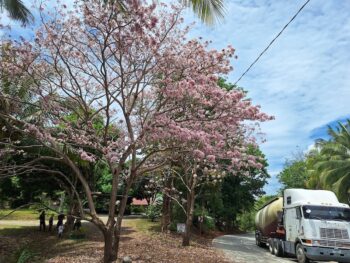DAVAO CITY (MindaNews/19 February) – Eighteen of Mindanao’s 26 provinces have been placed under Public Storm Warning Signal 1 as of 5 a.m. Tuesday as tropical depression ‘Crising,’ continues to move closer to Mindanao.
Six hours earlier, only14 provinces were under Signal 1, 10 more from the earlier advisory.
The Philippine Atmospheric, Geophysical and Astronomical Services Administration (PAGASA) has alerted residents living in low-lying and mountainous areas in these provinces against possible flashfloods and landslides as estimated rainfall is from 5 to 15 mm per hour within the 300-kilometer diameter of Crising.
In its Weather Bulletin No. 3 issued at 5 a.m. Tuesday, PAGASA said the center of ‘Crising’ as of 4 a.m. was estimated at 310 kilometers east of General Santos City, with maximum winds of 45 kilometers per hour (kph) near the center and forecast to move west northwest, now at 22 kph, from the previous 19 kph.
At 6 a.m. Crising was estimated at 280 km east of General Santos City.
Eight hours earlier, at 10 p.m. Monday, Crising was estimated at 470 km east of General Santos City with maximum winds of 45 kph near the center and forecast to move west northwest at 19 kph. Much earlier, at 4 p.m., Crising’s center was at 750 kilometers east of General Santos City with the same maximum sustained winds of 45 kph.
Weather Bulletin 3 said Crising is expected to be at 30 km northwest of Cotabato City by Wednesday morning and at 380 km northwest of Zamboanga City by Thursday morning. By Friday morning, it is expected to be at 450 km northwest of Puerto Princesa City.
Weather Bulletin 2 issued at 11 p.m Monday said Crising was expected to be at 40 km east of Davao City by Tuesday evening, at 150 km north of Zamboanga City by Wednesday evening and at 100 km southwest of Puerto Princesa City by Thursday evening.
Weather Bulletin 1 issued at 5:30 p..m. Monday, said Crising was expected to be at 350 km east of General Santos City by Tuesday afternoon, at 40 km southeast of Cotabato City by Wednesday afternoon and 220 km southeast of Zamboanga City by Thursday afternoon.
All six regions of Mindanao are represented in the 18 provinces under Signal 1: all of Davao, Southwestern Mindanao and Zamboanga regions – and portions of Caraga, Northern Mindanao and the Autonomous Region in Muslim Mindanao (ARMM).
Specifically, these are Davao del Norte, Davao del Sur, Davao Oriental, Compostela Valley of the Davao region; North Cotabato, Sultan Kudarat, South Cotabato and Sarangani of Soutwestern Mindanao region; Zamboanga del Norte, Zamboanga del Sur and Zamboanga Sibugay of the Zamboanga region; and portions of Caraga region (Agusan del Sur and the southern part of Surigao del Sur); portions of Northern Mindanao (Bukidnon, Lanao del Norte, Misamis Occidental), and the two provinces of the Autonomous Region in Muslim Mindanao in mainland Mindanao (Lanao del Sur, Maguindanao).
There are at least 24 cities within these 18 provinces: Tagum, Samal, Panabo, Davao, Digos, Mati, Kidapawan, Tacurong, General Santos, Koronadal, Dapitan, Dipolog, Pagadian, Zamboanga, Bayugan, Malaybalay, Valencia, Iligan, Ozamiz, Oroquieta, Tangub, Marawi, Cotabato and Bislig in the southern part of Surigao del Sur. Mindanao has 33 cities.
PAGASA urged the public and the disaster response coordinating councils to take appropriate actions such as preemptive evacuations and watch for the next bulletin at 11 a.m.
Local government units in the affected areas are now on the alert, having learned lessons from typhoons Sendong and Pablo in December 2O11 and 2012.
At least 1,200 persons died, mostly from drowning, in the cities of Cagayan de Oro and Iligan cities and portions of Bukidnon when Sendong hit these areas in 2011 while at least 1,000 died in Compostela Valley and Davao Oriental provinces when super typhoon Pablo made landfall in Baganga, Davao Oriental on December 4, 2012.
Classes in public and private pre-school and kindergarten are “automatically cancelled or suspended” in the areas placed under storm signal 1, according to Department of Education Order No. 43, which provides the guidelines for implementing Executive Order No. 66 on the cancellation or suspension of classes and offices during typhoons, floodings, weather disturbances and calamities
EO 66 also provides for localized cancellation or suspension of classes and work may be implemented by local chief executives, as chair of the Local Disaster Risk Reduction and Management Council (LDRRMC) concerned, in coordination with PAGASA and the National DRRMC, “specifically in f1ood-prone or high risk areas.”
“Announcements will be made not later than 4:30 a.m. of the day of the intended cancellation of classes and work, or not later than 11 a.m. for suspension of work and classes in the afternoon session, through diverse mass media, particularly radio and television, landline communications and other technologies for communication within the community or locality,” EO 66 states.
The DRMMC of Compostela Valley has announced that Governor Arturo Uy has ordered the suspension of classes in the elementary and high school levels.
In Sarangani, Governor Miguel Rene Dominguez has ordered the suspension of classes in all levels today.
Heavy rains were experienced by travelers from Dapitan City in Zamboanga del Norte to Oroquieta City in Misamis Occidental early Tuesday morning. Children were seen hurriedly going to school wearing raincoats or with umbrellas or banana leaves over their heads.
According to PAGASA, under Signal 1, winds of 45 to 60 kilometers per hour are expected within the next 36 hours. Among the impacts of the winds are: twigs and branches of trees may be broken; some banana plants may tilt or land flat on the ground; rice in flowering stage may suffer significant damage; some nipa and cogon houses may be partially unroofed; and travel of small seacrafts and fishing boats is risky. (Carolyn O. Arguillas with Bobby Timonera and Bong Sarmiento /MindaNews)
